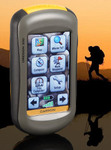Seems like a fantastic price for a very good unit. This is the lowest-spec Oregon.
Maybe this site would help: http://garminoregon.wikispaces.com/
Disadvantages vs higher spec Oregons:
24 MB built-in memory
No "World Wide Shaded" base map.
No unit-to-unit wireless transfer.
No barometric altimeter.
No electronic compass
No audible feedback (no beeper / speaker)
No 3-axis compass
Yellow plastic inner chassis (instead of light metal of 300+)


What would be the (difference in functionality) of getting this versus a cheap android around the $200 and using Google Maps & Navigation which has both walk and drive modes? Just trying to understand why someone would need one of these as opposed to a smartphone that has a GPS chip built in?